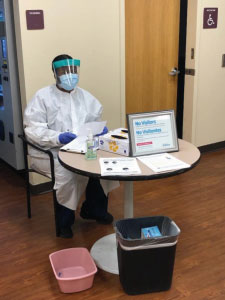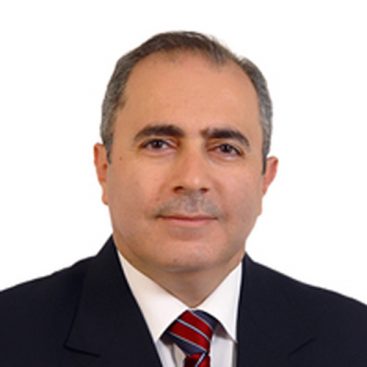COVID-19 poses an unprecedented threat to the modern world. Every region of the globe is affected, and dialysis services are particularly hit, with an unwell older population at increased risk of infection and mortality. Most haemodialysis patients are dialysed in centre and hence these patients are unable to self isolate, substantially increasing their risk of infection. Peritoneal dialysis patients may be less affected as they are better placed to practice social isolation.
The nephrology workforce is stretched, with an increased workload in both outpatient dialysis and inpatient consults for acute kidney injury secondary to COVID-19 infection. Healthcare workers are also falling ill or needing to be quarantined, further depleting the workforce at this time of increased need. Despite the significant psychological burden, centres around the world celebrate the resilience of their staff and their determination to care for their patients as best as possible.
Globally, mitigation strategies in dialysis units include:
- Temperature checking and health screening of staff and patients prior to entering units
- Cohorting (spatially and temporally) patients with suspected and proven COVID-19
- Maintaining social distancing within units, where possible
- PPE for staff when dealing with COVID-19+ or suspected patients
- Differing rules about the wearing of face masks for asymptomatic in-centre dialysis patients
- Educating patients on signs of COVID-19, social isolation and handwashing
- The use of telehealth in place of physical reviews
Major challenges reported include:
- Vastly increased workload with decreased staffing capacity
- Lack of test kits
- Lack of widespread testing, especially in outpatient facilities
- Initial false negatives with earlier test kits
- Lack of PPE
- Difficulties in transporting patients to and from dialysis when there is a lockdown
- Increased demand on dialysis services mean some centres have decreased number of sessions or number of hours per session for chronic haemodialysis patients
General measures for prevention
The following are general measures advised by Center for Disease Control (CDC)[6]. and the National Institute for Communicable Disease (NICD) [7]. of South Africa to minimize exposure to COVID-19:
- Wash your hands often with soap and water for at least 20 seconds. (https://www.youtube.com/watch?v=d914EnpU4Fo)
- If soap and water are not available, use an alcohol-based (>60% alcohol) hand sanitizer.
- Avoid touching your eyes, nose, and mouth with unwashed hands.
- Avoid close contact with people who are sick.
- Stay at home when you are sick and try and keep your distance from others at home.
- Cough or sneeze into a tissue or a flexed elbow, then throw the tissue into the bin.
- Clean and disinfect frequently touched objects and surfaces.
- Avoid touching surfaces used in public places. You may want to use a hand towel or tissue if possible when touching doorknobs, light switches, etc.
- You may want to take your shoes off when you enter your house. Some people have outdoor shoes and indoor shoes or slippers.
- Avoid greeting people with a handshake, hug or a kiss. A smile and a verbal greeting will be just fine.
- If you are sick, stay home, except to get medical care. Or if someone else is sick, avoid visiting or being with the sick person.
- If you have traveled to another country where the coronavirus has been confirmed or you have been with someone who has a confirmed case of the coronavirus, inform your health authority as you may need to be quarantined for 14 days.
- If you have concerns about being exposed to the coronavirus, use your judgment—you may want to avoid attending large public events, or travel to countries with with large numbers of infections.
- Contact your doctor if you feel sick. The main symptoms of the Coronavirus are: fever, cough, and shortness of breath. Your doctor can order a test if the Coronavirus infection is suspected.
- Avoid contact with farm or wild animals (alive or dead), animal markets, and products that come from animals (such as uncooked meat).
- Wear a facemask if you are sick and are around other people or visiting a health facility or if you are caring for someone who is sick
General management
All the patients with confirmed COVID-19 should be quarantined. Not all patients need hospital admission. In view of rapidly increasing demand, countries are developing hospitalization policies, In general, high-risk patients, or those with severe infection need admission in isolation units in designated hospitals. Supportive care, namely bed rest, nutritional and fluid support, maintenance of blood pressure and oxygenation are important measures, as for all critically ill patients.
The rapidly evolving crisis of COVID-19 continues to imperil our vulnerable dialysis population. The ISN thanks all contributors for providing insights on current regional situations and responses the pandemic.
Africa
Asia
Europe
North America
Oceania
South America
Senegal
 Contributor
Contributor
Dr Abdou Niang
Impact on patient care
A diabetic patient with COVID-19 was hospitalized in ICU and required one session of dialysis for acute kidney injury, but he died the following day.
The mobility of dialysis patients and nursing staff has been affected since the establishment of the state of emergency on March 23, 2020 with the introduction of a curfew, the prohibition of interurban transport, the closure of intercity bus stations and limitation of the number of passengers in public transport. Many chronic dialysis patients and some health professionals come to the dialysis center using public transport. They use masks face for protection. The third shift in some hemodialysis centers has been suspended because of the curfew. These patients were transferred to other hemodialysis centers. This mobility problem has led to the transfer of several patients to hemodialysis centers in their region of origin. However, the supply chain for dialysis supplies has not yet broken. The arteriovenous fistula program was also disrupted.
Impact on the dialysis workforce
This pandemic also has a definite psychological impact on the nursing staff as well as on the patients. To date, no professional involved in dialysis care is known to be infected or to have had contact with a COVID-19 positive patient. A suspicious case was noted in a hemodialysis center in the central region of Kaolack, but the RT-PCR confirmation was returned negative. After a follow up of 14 days without symptoms, patients was declared definitely not infected.
Preventative Strategies
A surveillance strategy has been set up under the coordination of the World Health Organization and the Senegalese ministry of health. By April 12th, 2020, Senegal has registered 280 patients infected with COVID-19, 171 have recovered, 2 have died and 106 remain under treatment. A Hydroxychloroquine protocol is being used in our country.
A dedicated COVID 19 positive hemodialysis center has been set up at the Aristide Le Dantec teaching hospital for the entire Dakar region. Other dedicated centers have been identified in the other regions.
To prepare, each health structure has defined an internal organization according to the recommendations of the Senegalese nephrology society (SOSENEPH). SOSENEPH has drawn up recommendations concerning preventive measures and management strategies for a COVID 19 positive dialysis patient or a COVID 19 positive patient with an indication for hemodialysis. Recommendations targeted also patients suffering from chronic kidney disease, kidney transplant recipients, health personnel and health authorities in the country. These recommendations are subject to change depending on the epidemic context. Theoretical and practical staff training sessions are conducted regularly in collaboration with the Ministry of Health and Social Action to prepare the response.
Policies, practices and guidelines
Senegalese guidelines are available here (current 10th April 2020)
Hong Kong


Contributor: Professor Sydney Tang, Professor Philip Li
Impact on patient care
COVID-19 began to affect Hong Kong toward the end of January 2020. With the experience of the SARS epidemic 2003, health authorities and workers were already on high alert very early on and adopted a containment approach by tracing all contacts of confirmed cases and quarantining them for 14 days as appropriate. Schools at all levels including universities suspended classes after the Chinese New Year holidays at around the same time.
To date, no dialysis patients in the dialysis units have been infected with SARS-CoV-2. All maintenance dialysis patients need to report any respiratory or GI symptoms and contact history and have their body temperature checked before entering the dialysis center. Any “suspected” patient suspected will be isolated and undergo testing for SARS-CoV-2 by PCR on a nasopharyngeal aspirate sample. Effort is made to space dialysis patients by 1.5m though this is not mandatory. All patients and healthcare workers wear facemasks at all times and practice diligent hand hygiene.
As Hong Kong adopts the PD-first policy, the hemodialysis unit becomes a pressure area as Tenckhoff catheter insertion procedures are cancelled resulting in an increased number of patients requiring bridging HD. HD support in isolation wards increases the demand for mobile HD service in some centers. For home HD patients, technicians are reluctant to provide maintenance service for fear of cross infection.
One regional center caring for over 400 PD patients observed a significant drop in PD-related peritonitis rate from 0.26 in the 4th quarter of 2019 to 0.19 episode per patient year in the first quarter of 2020. This may be related to heightened infection control measures particularly hand hygiene that is widely promoted by the health authorities. Hong Kong residents living in mainland China face difficulty as a result of quarantine requirements on crossing the borderline. This was resolved by working with PD fluid suppliers that have production lines in the Mainland.
Patients with stable allograft function will be refilled with medications without needing a consultation. For newly transplanted patients who are G6PD deficient and hence could not receive oral septrin (bactrim) for PCP prophylaxis, staff expressed concern in administering inhalational pentamidine for fear of aerosol related spread of infection.
Impact on dialysis workforce
There was some apprehension among dialysis staff during the early phase of the outbreak due to uncertainty in the face of an emergency response level issued by HA. This was compounded by worries on whether there would be sustained adequate supply of PPE. In many centers, nephrologists and trainees take turns to serve the isolation wards caring for COVID-19 struck patients and manpower is inevitably affected, albeit not to a great extent. Staff with the relevant travel history in early March are to complete a 14-day home quarantine before returning to work. To date no healthcare workers in dialysis units have been infected with SARS-CoV-2
Preventative measures
The Centre for Health Protection (CHP) has given health advice to prevent pneumonia and respiratory tract infection. Renal patients are recommended to always maintain good personal and environmental hygiene; wear a surgical mask when entering hospital/community dialysis centres. As per recommendations from the Hospital Authority (HA) Central Renal Committee, patients on HD are recommended to-
- Avoid close contact with persons with fever or respiratory symptoms in countries/areas with possible transmission of novel coronavirus infection. If it is unavoidable to come into contact with them, put on a surgical mask and continue to do so until 14 days after returning to Hong Kong;
- If travelling outside Hong Kong is unavoidable, avoid visiting hospitals. If it is necessary to visit a hospital, put on a surgical mask and observe strict personal and hand hygiene;
- If feeling unwell when outside Hong Kong, especially if having a fever or cough, wear a surgical mask and seek medical advice at once;
- After returning to Hong Kong, consult a doctor promptly if having a fever or other symptoms, take the initiative to inform the doctor of any recent travel history and any exposure to animals, and wear a surgical mask to help prevent spread of the disease.
Similarly, PD patients are strongly reminded of the following in handling of PD effluent-
- Drain the PDF effluent directly into the toilet bowl, avoid splashing (in case of spillage, clean the spills immediately by diluted bleach 1:49);
- Put on appropriate Personal Protective Equipment when diluting or using bleach as it irritates mucous membranes, the skin and the airway;
- Mix 40ml of household bleach with 2 litres of water to achieve 1:49 dilution;
- Pour the 2 litres diluted bleach into toilet bowl, avoid splashing;
- Flush the toilet bowl after 30 minutes (with the toilet lid closed);
- Discard the emptied CAPD bag and tubing into a domestic waste bag, and wash hands with liquid soap and water immediately.
To minimize patients coming back to hospital, some routine tests like PET and dialysis adequacy assessment are postponed. All potential cadaveric kidney donors must have a negative SARS-CoV-2 testing result before organ acceptance.
Policies, practices and guideline
The Hospital Authority (HA) Central Renal Committee has issued an infection control recommendation to renal patients undergoing HD and PD in Jan 2020 as above.
Hong Kong



Contributor: Dr. Angela Yee-Moon Wang, Dr. Lau Chak Sing Dr. Ivan Fan-Ngai Hung
Impact on patient care
Patients including those on dialysis are worried of acquiring COVID-19 when coming to hospital and their needs to return to hospitals are minimized except for absolute essential issues such as attending hemodialysis or intermittent peritoneal dialysis (PD), seeking consultation for acute peritonitis, severe exit site infections or fluid overload that compromised breathing. Very stable patients may defer their clinic follow-up and return only for refill of drugs and PD fluid prescription. Patients and caregivers are encouraged to call dialysis centre for treatment guidance to minimize coming to hospitals. Under the directive of HA, elective, non-emergency services and operations are rescheduled in HA hospitals to focus resources to cope with SARS-CoV-2 including arteriovenous fistula creation and tenchkoff catheter insertion. Hemodialysis centres need to run in full capacity to provide temporary dialysis for patients waiting for tenchkoff catheter insertion. On the other hand, CAPD training is expedited to avoid hospital admissions for intermittent PD. As hospitals suspend visitors except on compassionate grounds, some patients especially elderly who do not use mobile phone expressed feelings of loneliness, depression and lacking emotional support from family.Patients with positive screening will be isolated and undergo SARS-CoV-2 diagnostic testing by having a nasopharyngeal flocked swab (NPS) and now a deep throat saliva for SARS-CoV-2 reverse-transcriptase-polymerase chain reaction (RT-PCR). Staff will wear N95 mask and personal protection equipment (PPE) to perform NPS in isolation room with negative pressure. If SARS-CoV-2 test is preliminary positive, the tested sample will be sent to Public Health Laboratory of Department of Health to reconfirm positivity before initiate treatment. Both suspected and confirmed cases are managed in airborn infection isolation rooms (AIIRS) in Hospital Authority (HA) hospitals. All SARS-CoV-2 positive cases are reported to the Notifiable Diseases and Outbreak Reporting System (NDORS) for further contact tracing and quarantine of close contacts by Center for Health Protection. If screening is negative or SARS-CoV-2 test is negative, patient can proceed with dialysis as scheduled. All SARS-Co-V2 positive patients undergo chest radiograph and selected severe cases have thoracic computed tomography.
So far, no dialysis patients in Hong Kong are affected by COVID-19. Our patients are generally very compliant to staff’s education on mask wearing, hands hygiene and social distancing measures. Our previous experiences with SARS in 2003 and management strategies adopted including early isolation of suspected and confirmed cases and early treatment appear effective in keeping a very low overall mortality rate and complication rates from COVID-19 infection
Impact on dialysis workforce
The COVID-19 pandemic has caused fear, uncertainty, stress and anxiety among healthcare workers including nephrologists. There are fear among staff of acquiring the infection at work and worries of not having enough personal protection equipment (PPE) supply to work in high-risk areas with the big global demand of N95 mask and PPE. Psychological support service is available to healthcare workers if needed. Medical staff from different specialties and departments rotated to work in AIIRS, reducing usual manpower within specialties. With all the precautionary and infection control measures in place, no healthcare workers in HA was infected with COVID-19 at work. Healthcare workers are very vigilant and observe mask wearing and hands hygiene measures. There are frequent regular cleaning and disinfection of all the surfaces, machines in hospitals areas to keep environment clean.
Preventative measures
Screening is compulsory for outpatients including dialysis centres for fever or other symptoms of acute respiratory infections, pneumonia, occupation, travel history, contact with anyone who has developed COVID-19 and clustering or family with COVID-19 related symptoms within last 14 days. Patients with recent travel history will self-quarantine 14 days and reschedule clinic follow-up. All seating distance in hospital, clinic waiting areas or dialysis centres are kept at least 1.5 metres apart if feasible.
Policies, practices and guideline
Hong Kong Government activated ‘Emergency Level’ on 25 Jan 2020 and announced “Preparedness and Response Plan for Novel Infectious Disease of Public Health Significance”. Guidelines on infection control measures developed by Center for Health Protection (CHP) of Hong Kong are available online
https://www.chp.gov.hk/en/index.html and
https://www.coronavirus.gov.hk/eng/index.html#Resource_Centre
India

Contributor
Assistant Professor Raja Ramachandran
Impact on patient care
To date, the number of COVID positive patients in India is 13,428 of the 300,000 patients tested (16th April 2020). At least 50 are health care workers. The exact number of chronic kidney disease (CKD) stage VD is not known; however, a conservative estimate suggests at least 50 patients on maintenance hemodialysis have tested positive for SARS-COV2. The government directive mandates COVID19 dedicated facility management for all the patients of SARS-COV2 infection.
Currently, India is in the fourth week of complete lockdown to curtail the spread of the infection. Post-lockdown, there has been a reduction in a total tally of COVID19 infection. Currently, all COVID19 patients are dialysed at a COVID19 designated hospital to ensure isolation. The expected big wave of COVID19 positive ESRD cases have not yet reached us, once we are overwhelmed, we may have to plan dialysing patients of COVID19 with mild symptoms at a routine dialysis centre practising isolation.
Consequential to the lockdown, the patients with CKD are facing many hassles hampering optimal ESRD care. They include difficulties travelling to the dialysis facility, exorbitant or surge pricing of the cabs, difficulties in medication and consumables delivery to the dialysis centres, shutting down of the (non-designated-COVID centres) dialysis units/hospitals for a fortnight in case of COVID19 positive detection, reduction in the frequency of dialysis from three to two per week with adjunctive “nephron blockade” and cancellation of planned surgeries including arteriovenous fistula surgery. Resultant to the issues mentioned above, most dialysis centres are not enrolling newly diagnosed ESRD patients, and those shifted from the closed units.
Renal transplant patients staying in far-flung areas (with limited medical access) are facing the non-availability of the post-transplant immunosuppression or a different brand on sale, with an inability to monitor drug levels.
Impact on dialysis workforce
The dialysis workforce is very apprehensive, as the government recommends 2-week quarantine to HCW if any patients under their close care are detected positive for COVID19. During their confinement, they are without any aid or financial compensation, resulting in demotivation, which has a ripple effect on the other HCWs
Preventive measures
The ministry of health and family welfare has framed a guideline for dialysis of COVID19 patients. The guideline recommends screening of all the patients for SARI symptoms and universal use of a triple-layer surgical mask for dialysis personals, attendants and caregivers. Also, they recommend isolation for “suspected COVID19” patients or in case of non-availability to dialyse them in the last shift, at a corner two feet away from the other patient with the dialysis caregivers using adequate personnel protection equipment. Dialysis workforce and patients are educated about COVID19 and preventive measures (hand wash, cough etiquettes, and avoiding unnecessary contact with people). There has been a significant change in outpatient care with an institutionalised telecommunication strategy. CAPD, as a modality of RRT, is promoted to patients with resource and access. All the renal transplant surgeries are currently on hold, and all the renal transplant recipients are advised strict quarantine.
Kazakhstan

Contributor
Dr Abduzhappar Gaipov
Impact on patient care
In the current situation, as of April 8th, 2020, there are 727 confirmed cases with 54 recoveries and 7 fatalities in Kazakhstan due to COVID-19. To date, none of our patients on dialysis have COVID-19.
Impact on the dialysis workforce
Overall, 120 medical staff including physicians were infected during their duties. However, self-quarantine was mandatory for some of our medical staff because of potential contacts with COVID-19 patients. Our nephrologists are responsible for the critically ill patients who required renal replacement therapy.
Preventative strategies
Several hospitals were involved in the COVID-19 surge (extra beds, departments, ICU beds, etc.) and staff was compensated for the additional work. each region and major cities of Kazakhstan.
Policies, practices and guidelines
We do not have specific management but adhere to those provided by the ISN and ERA-EDTA. We have an algorithm that was developed similar to Russians. Each big cities and regions have infectious disease hospitals (we call them ID dispensers), mostly and provisional hospitals. All ID hospitals will be equipped with at least one dialysis machine for dialysis patients, as well as each ICU should have CRRT machines.
During the next couple of weeks, many in Kazakhstan will be screening for COVID-19, especially in high-risk groups and we hope dialysis patients will be among them. The national guideline on COVID-19 diagnostics and treatment was approved on April 1st, 2020.
Nepal

Contributor
Professor Dibya Singh Shah
Impact on patient care
With the global Pandemic of COVID -19, Nepal reported its first COVID-19 case on 24th January in a 32-year-old male Nepali student who had returned from Wuhan. Subsequently, the second case was confirmed on 23rd of March and following that series of cases has been detected in different parts of Nepal. As of 28th April, 54 COVID-19 cases have been confirmed. There has been no mortality reported so far and none of them have kidney disease.
There was some concern regarding the possibility of dialysis supplies running out of stock but so far none of the centers have faced this. Renal transplantation services have been suspended all over the country since 24th of March, after lock down was implemented. Initially there were some issues with transportation for patients and food in some centers as the cafeterias were closed. Now there are dedicated ambulance and transportation services are provided by local municipalities for dialysis patients. Many social organizations are helping with food and other essential supplies for patients and their accompanying persons.
Impact on dialysis workforce
Outpatient dialysis services and acute inpatient dialysis services are running smoothly, however there is a generalized fear among the patients as well as medical staff of getting infected with the virus. There was some panic among the dialysis staff initially, however now things are better with education and awareness.
Preventative measures
All dialysis centers are screening patients and visitors with thermal device for febrile illness at the entry point. Patients with positive
symptoms or positive history of recent travel or contact are sent for isolation and tested for COVID. Leaflets and charts explaining hand washing, protection during coughing, sneezing and regarding the symptoms are widely circulated. It is mandatory to wear masks for all patients and visitors in dialysis centers. Dialysis center staffs are taking strict infection control measures with gloves, goggles and mask. Separate hospitals are identified to provide dialysis in case of COVID19 positive patients needing dialysis.
Pakistan

Contributor
Prof. Rubina Naqvi
Impact on patient care
As of April 24, 2020, government figures total 11,000 affected with 230 deaths. There must be many more people who are either asymptomatic or if symptomatic they are hiding their symptoms because of fear being isolated or mal-treated by community. Some also fear losing their job, or are essential carers for their family and cannot spare themselves to isolate. There are also limited test kits available. Therefore, assessing the actual number of COVID 19 positive people in the country is next to impossible.
Sindh Institute of Urology and Transplantation (SIUT) daily has 990 registered hemodialysis patients coming for regular dialysis. During the last two weeks, 14 registered dialysis patients tested COVID 19 positive, but many were not tested for various reasons. Registered dialysis patients may hide their symptoms because of fear that they might be deprived of life saving treatment, which is not reality as all big nephrology centers in country have designed their guidelines for dialysis patients and have plans to deal with dialysis patients found to be COVID 19 positive.
A total of 130 non-renal patients were admitted to SIUT with COVID 19 during this period and two of them developed renal dysfunction.
Impact on dialysis workforce
In the last two weeks, 16 health care professionals including doctors, nurses, ICU and dialysis technicians have tested COVID-19 positive.
In addition, health care personnel with limited resources sometimes take decisions which may lead to psychological trauma. End stage renal failure (ESRF) patients whether already registered in dialysis programs or coming for the first time in the ER may have uremic symptoms which mimic defined COVID 19 symptoms. It is challenging to decide whether to direct them towards the area designated for COVID 19 patients at any renal unit or proceed with their emergency procedures of attaining angio-access and starting dialysis as per routine.
Preventative measures
SIUT has started doing screening of the general population (non-renal) and is one of state designated institution for performing tests. SIUT has developed an isolation ward (35 beds) and an ICU (14 stations) for COVID 19 positive patients along with a Triage with ER and specified place for dialysis.
Policies, practices and guidelines
The Center of Biomedical Ethics and Culture (CBEC) at SIUR has also developed a set of concise guidelines providing a broad ethical framework for making decisions, though the main focus is to address areas like allocation of scarce resources such as ICU beds or providing mechanical ventilation.
The guidelines for our haemodialysis patients are:
- During dialysis your mouth and nose should be covered all the time with surgical mask.
- You should have your hand sanitizer with you and rub your hands with sanitizer frequently while you are in hospital.
- You should avoid eating and drinking in dialysis room, but can bring toffee or chocolate in your pocket or purse so that you can take in case your blood sugar levels decrease.
- If you or any of your family members has fever, cough or difficulty in breathing or known to have Corona test positive, you should call to dialysis center and inform staff, so that they arrange your dialysis in isolation.
- More than one relative/attendant with one patient is strictly forbidden, avoid gathering in or outside dialysis room.
- Patients will be checked for their body temperature before entering in dialysis room
- After finishing your dialysis when you return home take bath, change clothing, wash your spectacles with soap and clean your mobile phone and purse
Singapore

Contributor
Dr Marjorie Foo
Impact on patient care
Singapore is a densely populated urban island-state country, with a population of 5.7M.
(https://singstats.gov.sg). Singapore has approximately 8000 prevalent dialysis patients and
1600 transplant patients (https://nrdo.gov.sg) and 116 nephrologists (https://smc.gov.sg).
As of April 14, there has been 2918 cases giving incidence of approximately 510 pmp with 9 deaths (0.3%) and 586 recoveries (https://moh.gov.sg). Less than 10% of the affected patients developed acute kidney injury (AKI) that requires renal replacement.
Preventative Measures
Dedicated areas in the renal ward with “in-ward” dialysis facilities were set up as “high-alert areas to cater for hemodialysis (HD) patients with respiratory symptoms but do not meet the Ministry of Health criteria as “suspect” cases. This set up allows segregation of HD patients with respiratory symptoms from the hospital’s main dialysis centre while pending the results of their swabs. Patients remain in this “high-alert” area till 2 swabs are negative. Patients who tested positive will be transferred to isolation rooms with dialysis capability. High-alert areas enforces higher level of personal protection equipment to be worn. Doctors and nurses are segregated to frontline or routine in- and out-patient care areas.
The team worked with facilities department to identify isolation rooms with dialysis capability while sourcing for more dialysis paraphernalia like portable reverse osmosis machines and looking for areas for expansion. Transplant program was put on hold.
Peritoneal dialysis(PD) patients are converted to day-APD for better monitoring and
troubleshooting. When dialysis machines (HD or PD) are in short supply, staggering of
treatment will allow more patients to have dialysis. Acute PD for AKI is a consideration.
Outpatient services are reduced. Upcoming cases are screened, patients informed and
medications delivered to their home.
Community HD centres follow advisory from the Ministry of Health (MOH) with regards to screening and discourages change of shifts for patients and nurses for ease of contact tracing. Confirmed cases are sent to NCID and contacts are isolated at home with dedicated transport to bring them to designated dialysis centres. Tele-nephrology in HD centres are rapidly scaled up to fast track failing access for treatment, minimising hospitalisation.
PD centre continues to train patients, conforming to social distancing and wearing masks at all times. Home visits are only performed in special cases where without which will result in hospitalisation. Virtual treatment monitoring and 24hr hotline for technical and clinical services strengthened patient home support. Palliation services continues with screening in place.
Policies, practices and guidelines
Nephrologists set up secure chat groups to discuss treatment strategies, resource and manpower management; aligning treatment criteria to optimise use of consumables. There needs to be constant monitoring of resources at a local and national level as well as keeping census across the country for updates of AKI cases and outcomes. Establishment of close communication with vendors is essential for regular updates of their stock inventory and
delivery logistics, to ensure supply continuity. Peer support group is set up to monitor for burn-out.
Further Acknowledgements: Drs KT Woo, CM Chan, CS Tan
South Korea

Contributor
Dr Gheun-Ho Kim
Impact on patient care
In South Korea, the first case was diagnosed as COVID-19 positive on January 20, 2020. As of April 5, 2020, overall 10,237 patients were diagnosed to have the infection. Among them, 14 patients, 8 medical personnel, and 2 caregivers were diagnosed with COVID-19 in hemodialysis units through April 5, 2020. Two dialysis patients died, but no mortality was from healthcare workers. This situational change must have imposed a physical and psychological burden to the patients. They may have felt panic or depressed about isolation treatment.
For dialysis centers where COVID-19-infected cases occurred, nurses were redistributed among the affiliated hospitals of a university. When confirmed or suspected cases were found in the dialysis unit, they were spatially and temporally separate from other dialysis patients. When portable R/O was unavailable, the patient needed to have dialysis access catheter for continuous renal replacement therapy.
Impact on the dialysis workforce
There are two major spots of COVID-19 outbreaks in South Korea. One is Daegu area in late February to March, and the other is Seoul in late March. As of April 5, COVID-19 infection cases were from 11 dialysis units in Daegu and 3 units in Seoul. In Daegu, 14 dialysis patients and 10 healthcare workers (physician 1, nurses 7, caregivers 2) were infected. In Seoul, two dialysis patients (in 3 units) were diagnosed to have COVID-19, but no healthcare workers were involved. Many patients and healthcare workers were unable to work because of self-imposed quarantine. The health official (epidemic control commissioner) discerned contacts by CCTV records etc.
Preventative Strategies
Dialysis patients were educated about personal hygiene such as hand washing, wearing masks, and avoiding unnecessary contact. The surgical masks and hand sanitizer should be available at the entrance of the HD unit. The healthcare workers, HD patients and their caregivers should perform standard, contact, and droplet precautions including hand hygiene and wearing masks. Each HD unit should prepare the adequate environment to minimize infection transmission such as keeping the proper distance between beds. The waiting room or resting area should be closed and each HD patient should come in at a reserved time to minimize patient-to-patient contact. Before arrival at the HD unit, all HD patients should be asked about their prior visit to other countries and domestic outbreak regions, any patient contact history, and their clinical symptoms. In addition, if the patient has a fever, cough, or shortness of breath, they should call first and let the healthcare worker know about their symptoms before they visit the HD unit. All HD patients should enter the HD unit under the permission of the physician only if they do not have suspicious signs or symptoms of COVID-19. It is most important not to allow suspected or confirmed COVID-19 patients enter the HD unit. Each HD unit should prevent secondary transmission of infection by restricting the caregivers or visitors not to come in the HD unit.
Policies, practices and guidelines
An article will appear this month in Kidney Res Clin Pract: “Korean Clinical Practice Guidelines for Preventing Transmission of Coronavirus Disease 2019 (COVID-19) in Hemodialysis Facilities”. Our previous experiences of fighting against MERS (Middle Eastern Respiratory Syndrome) and developing infection control guideline for HD facilities were largely helpful to promptly respond to COVID-19 outbreak.
Further Acknowledgements: Drs.Young-Ki Lee and Hayne Cho Park
Syria

Contributor
Dr Bassam Saeed
Impact on patient care
To date, no patients on dialysis or on immunosuppressive treatment due to glomerulonephritis or having a kidney transplant have been admitted or known to have COVID-19 infection. There are 5000 Syrians receiving maintenance dialysis treatment.
As of April 11, 2020, a total of 25 Covid-19 positives were reported inside Syria since the beginning of this pandemic. Interestingly, none of them were found to have any kidney disease. So far, 3 cases recovered and another 2 cases died; therefore, although the total number of patients is too low, a mortality rate of 8% seems higher than what’s reported in China for instance (1.4%–3.6%), but could be lower as case finding increases. Because testing kits for confirming COVID-19 infection were not available in sufficient quantities at the start of the pandemic in the country, diagnostic tests were performed only for those who are in critical condition or need hospitalization. Consequently, one could speculate that only severe cases were diagnosed while a much higher number of infected people remain undiagnosed just because they have mild presentations or they are simply asymptomatic. Recently, things seem a bit better as testing for the virus becomes more accessible. On average a total of 100 tests are being done on a daily basis and efforts are being made to perform up to 200-300 tests a day.
Preventative strategies
In April 05, 2020; The Syrian Technical and Advisory Team for Corona Pandemic Treatment held a meeting and came out with a treatment protocol based on patient characteristics, phase of illness and disease severity using antivirals and immunosuppressive agents. This protocol is based on empirical observations in other countries. However, this protocol didn’t include any management plan for haemodialysis and transplant patients with COVID-19 infection.
The government has instructed public to stay at home if not at work and suspended all schools, colleges, shopping malls and other shops except pharmacies, medical clinics, and food shops. The government imposed a partial curfew from 6 PM to 6 AM with heavy penalties.
All patients on dialysis are advised to respect social distancing rules since early stages of the coronavirus crisis. Standard contact and droplet precautions, including isolation gowns, gloves, masks, and eye protection and other; personal protective equipment (PPE) have been implemented. Routine disinfection practices including disinfection wipes for the dialysis machine, chair, and all dialysis station surfaces and equipment are being used. Preserving and prioritizing PPE for healthcare workers and patients is a challenge.
Impact on the dialysis workforce
Another crucial challenge is management of workforce. Actions were taken such as creating alternate schedules and limiting prolonged exposure to clinical areas. We adopted surveillance measures for outpatients undergoing hemodialysis. These were applied in locations for donning and doffing PPE with temperature checks, brief clinical evaluation, provision of alcohol-based hand sanitizer and surgical masks. If the patient is suspected to have COVID-19, they will be referred to a pulmonologist. In case of urgency for dialysis treatment, this must be performed in an isolation room intended for suspected cases. Many dialysis units rearranged spaces to create hemodialysis rooms, intended partially for COVID-19 positive patients.
Most of our patients with COVID-19 typically had mild symptoms and survived the infection with no complications.
Further Acknowledgements:
Bassam Saeed, Ammar Raiy, Ruba Baradie, Nizar Ajram, Waseem Maksoud, Kussai Hassan, Najiyeh Ramadan, Ayham Mulhem, Ruba Nashawati, Huda Mazloum, Tarek Barazi, Hala Wannous, Samer Hassan, Lina Deeb, Rebhi
Saadi, Abdallah Al Sayyed, Sami Bitar, Ayman Aziz, Nadim Shehabi, Ahmad Saffo, Mazen Hmeidi, Ibrahim Sleiman, Sahar Saad, Aref Naddaf, Hassan Ahmad, Bashar Jandali, Kussai Khaddour, Raji Shahda, Madleen Talgeh, Najat Abouzor, Afram Kourriyeh, Yasser Ahmad, Mahmoud Khashab.
Japan

Contributor
Professor Masaomi Nangaku
Impact on patient care
In Japan, the first patient of Covid-19, who came back from Wuhan, was reported on Jan 15. On Feb 3, the famous cruise ship hosting 3711 people with many Covid-19 patients came to Yokohama. Until mid-Feb, most Covid-19 patients were those who came back from foreign countries or had link with other Covid-19 patients. However, the number of patients, especially those without links with other Covid-19 patients, increased dramatically after mid-Mar. On April 1 President of the Japan Medical Association declared “Medical Crisis”. On April 4 the Japanese government finally declared “emergency” at seven prefectures, including Tokyo Metropolis and expanded “emergency” to all the nation on April 16.
The strange characteristic of Japan is the very small number of PCR analyses occurring to diagnose Covid-19 in spite of the large population (40,263 tests in the total population of 126.5 million on April 8). The Japanese prime minister announced that the government secured 28,000 beds for Covid-19 patients on April 6, but this is suspected to be overstatement because the number is more than 2.5 times of the sum of the total number of beds which all the prefectures secured (10,607 beds). Many hospitals are slowing regular healthcare routine down. On April 9, Japanese Association for Acute Medicine and Japanese Society for Emergency Medicine announced that many hospitals have difficulty in accepting patients with severe acute illness because of the outbreak of Covid-19.
By the end of April 16, total number of confirmed cases in Japan was 9,167 and total number of deaths was 148 (mortality 1.6%). On April 17, the number of new Covid-19 infection per day in Tokyo Metropolis became more than 200 for the first time.
Impact on the dialysis workforce
Japan has a huge dialysis population. At the end of 2018, the number of prevalent dialysis patients was 339,841, which corresponds to 2,688 per million population. According to the preliminary report by Japanese Society of Dialysis Physicians, the number of dialysis patients with confirmed COVID-19 infection was 47 with 4 deaths on April 17.
Preventative Strategies
The Japanese society of Nephrology (JSN) made a website about COVID-19 (https://www.jsn.or.jp/covid19/) and introduced the activity of the ISN to the members of JSN. The Japanese Society of Dialysis Physicians released guidance documents for dialysis and renal transplantation patients to be shared with the public, and the latest version (4th edition) was published on April 3
(http://www.touseki-ikai.or.jp/htm/03_info/doc/20200402_corona_virus_15.pdf).
JSN and Japanese Society for Dialysis Therapy help with the distribution of the documents. According to this guidance, all HD patients have temperature measurements every morning. If they have a temperature of more than 37.5C° or symptoms of common cold, they report to dialysis clinics by telephone in advance. Patients with cough should wear masks. Patients with suspected or confirmed COVID-19 infection should arrange personal transportation. Their pass route for entering hospital and dialysis unit should not be shared with other dialysis patients. Patients with suspected or confirmed COVID-19 infection should be dialyzed in a separate room. If the capacity of the isolation dialysis is overloaded, social distance (more than 2m) with curtain or partitioning screen should be employed during dialysis treatment. If spatial isolation is difficult or there are many patients, change of dialysis shifts for temporal isolation may be required. Equipment that may come into contact with patients or potentially contaminated material should be disinfected according to standard protocols after dialysis.
Denmark

Contributor
Professor Bo Feldt-Rasmussen
Impact on patient care
In Denmark we have been able to control the epidemic during the first month. As of April 15, about 300 have died in Denmark which is about 50 per million inhabitants. Hospital admissions are declining and the number of patients in intensive care units with need of ventilators is going down.
Patients on ventilators at ICU have in many cases used CRRT. Some have needed hemodialysis for a short period afterwards, but we have had capacity to meet these needs. Unfortunately, some ICU patients get so terribly ill and can´t be saved, even younger patients with no comorbidities.
So far we have had no capacity issues in any of the dialysis centres of the Capital Region. In the Capital Region we are taking care of about 900 dialysis patients (about 700 HD and 200 PD). Very few have been infected, two with many comorbidities have died.
An area of concern is that Patients with many other diseases are now on rapidly growing waiting lists because of the highly needed focus and allocation of resources to COVID.
Impact on the dialysis workforce
Nephrologists and nurses have only to a minor extent been infected. At one hospital, we have had two out of 26 doctors verified infected. Three nurses and one secretary out of a staff of 250 has been documented with COVID 19. We have been able to include staff that have previously been working with dialysis in order to meet demands of increased sick leave.
The staff have been worried, in particular in the beginning. As time has passed the staff are acting very professionally and calm.
Preventative strategies
Denmark is a public health service system with open and free access to all medical treatments to all. It has therefore been possible to plan and implement a national strategy to close down parts of the health service system in order to transfer and train staff to work with all aspects of COVID in new settings. New ICU´s with ventilators have rapidly been established and we have not had any problems with capacity so far.
We managed to build up a high capacity of these ICU beds with ventilators and to train nurses and doctors to handle these patients within the first weeks. We now have an overcapacity and the society is now planning to gradually open. We therefore expect more cases in the near future.
Specific to dialysis, we have planned with separate rooms for isolation of patients suspected of COVID until falsified or verified. We have plans for separate or cluster isolation as the epidemic might escalate. We have been able to include staff that have previously been working with dialysis in order to meet demands of increased sick leave. The staff has been educated in dealing with these patients.
France

Contributor
Professor Eric Daugas
Impact on patient care
According to a specific transversal survey performed on March 30th by the Agence de la Biomedecine in charge of the REIN registry -a national prospective registry listing all ESRD patients, who started a renal replacement – almost three weeks after the beginning of pandemic in France, 298 dialysis patients were recorded in France as COVID positive with 37 (12.5%) deaths in this population. These numbers are preliminary and obviously under evaluated due to the incomplete gathering of cases and also considering that mortality will be observed later in some of these ongoing cases.
Subjectively, we must consider that the pandemic in dialysis patients population had quickly expanded considering that currently all dialysis centers in the geographic area have now organized specific dialysis sessions for COVID positive patients. A large proportion, up to one-third of the dialysis patients is now affected by the disease. The initial expansion of the pandemic in patients with ESKD was largely located in the east of France and in Ile-de-France, – which are the most impacted regions in France. This maybe in part due to the delay between the real but imperceptible beginning of the pandemic and the implementation of segregation measures of dialysis patients according to their COVID-19 status in specific dialysis sessions with dedicated care givers.
Impact on the dialysis workforce
In spite of initial apprehension, all members of our staff committed to the new challenge and turned to a positive mind to offer their best to the patients. The solidarity between the dialysis centers in the area allowed an efficient repartition of the patients according to their individual need to be referred to hospitalization. Even, health care professionals with specific skills for dialysis, who were recently retired or who moved to other professional orientations, came back to us as volunteers and proposed their help for dialysis of COVID positive patients. Still, this is clearly helpful considering that some caregivers in dialysis centers are now unable to work due to contamination by the virus. It is too early to measure their proportion, and I can only give the information from our center, where five members of our dialysis staff including one nephrologist contracted the disease, which roughly corresponds to a proportion of 15 %. It should be underlined that the usual financial barriers usually used to control the health expenditure in our hospitals have been quickly lifted allowing the fast recruitment of these volunteers in our centers.
Preventive measures
We now have national and regional guidelines available for patient transportation for caregivers’ protection. Currently, it is more challenging to establish treatment guidelines for COVID-19 and even more for dialysis patients. Each center developed its treatment proposal with a highly empirical approach due to the absence of definitive treatment evaluations. Locally we apply treatment guidelines proposed for all patients to dialysis patients according to the pharmacokinetic specificity and contraindications in ESRD patients (for instance, we considered the ratio benefit over risk of hydroxychloroquine unfavorable in dialysis patients).
Italy

Contributor
Prof. Giuseppe Remuzzi, Prof. Fabio Paglialonga
Impact on patient care
The Italian Society of Nephrology conducted a national survey with data provision for 54% of patients treated by HD (17,774 from total 36,433) or PD (2,252 from total 4,143 patients) in the Italy. According to this survey, at the national level 2.8% and 0.6% are COVID-19 positive on HD and PD (521 and 18 patients), respectively. In Lombardy, which is among of the most affected by the epidemic regions, these percentages are 7.4% and 0.7% (333 and 7 patients), respectively.
From the patients having COVID-19 infection, the isolation at the dialysis center was possible to 311 and 5 patients on HD and PD in the Italy in total, and to 249 and 4 patients on HD and PD in the Lombardy region. The clinical conditions of many patients require to hospitalize them to semi-intensive or intensive care units. From the 577 COVID-19 positive patients in Italy, 103 required semi-intensive and 24 intensive care, in Lombardy these numbers were 57 and 3, respectively. Many of them had unfavourable outcome, with 147 patients died in Italy in total (139 receiving HD and 8 PD), and 88 in Lombardy (86 and 2, respectively). These numbers equal to 25.5% mortality rate among dialysis patients in Italy in total and 25.9% in Lombardy.
Impact on dialysis workforce
The medical staff is also affected by the COVID-19 infection, and at April 7 there were 156 dialysis healthcare workers with confirmed positive tests in Italy, among them 103 were in the Lombardy region.
Preventative measures
There are no officially adopted guidelines at the national level, but every dialysis center introduced protective measures to prevent the COVID-19 spread. A total of 154 from 173 centers modified their protocols for transporting patients to and from Professor Giuseppe Remuzzi home to the dialysis treatment. Instructions were issued to patients to follow social distancing, washing hands frequently, wear surgical masks in the presence of others, on public transport and in dialysis units. Patients were contacted prior to dialysis and screened for symptoms. Waiting rooms were refurbished to allow social distancing and patients temperatures were checked on arrival. Symptomatic patients are evaluated by a nephrologist and infectious disease physician and, if possible, dialysis is delayed until swab results are back (4-6 hours). COVID positive patients are assessed at the positive COVID Emergency Unit to decide whether they deserve hospitalization or not. For Covid19 positive patients who do not need hospitalization, they usually return home after dialysis with mandatory recommendations for strict isolation from their family members. COVID+ patients are cohorted in dialysis areas.
All dialysis staff (doctors, nurses, cleaners, transporters etc) are instructed to use surgical masks during their stay at the centre and/or at any time when contacting a dialysis patient. Staff are also requested to report respiratory symptoms or fever to the designated authorities of the hospital to decide whether they can be admitted back to work or not (with or without COVID19 swab).
There are substantial variations in the testing procedures and criteria by centres: 110 performed tested only in symptomatic patients, 47 in patients with history of contacts with infected persons, 14 centres performed tests in all patients. These discrepancies are also observed in Lombardy, Italy.
Spain (Madrid and Barcelona)

Contributor
Dr Maria José Soler, Professor Manuel Praga Terente
Impact on patient care
So far, our institution in Madrid has treated 215 active hemodialysis patients and 39 peritoneal dialysis patients. Up to now, 28 dialysis patients (11%) has tested positive for COVID-19. Of them, 25 patients (23 HD patients, 2 PD patients) required hospital admission. The most common symptoms in our patients who required hospital admission (23 HD patients, 2 PD patients) were fever (64%), non-productive cough (64%), dyspnea (40%), gastrointestinal symptoms (20%) and myalgias (24%). The most frequent biochemical findings were a high C-reactive protein, D-dimer elevation, and a moderate decrease in the lymphocyte count. Chest X-ray showed ground glass opacities in 60% of the cases, alveolar consolidations in 30% and bilateral pulmonary involvement in 64%. Most patients were treated with hydroxychloroquine (96%)- see Treatment Algorithm . Other therapeutic regimens were added according to clinical course and severity: lopinavir/ritonavir (48%), a 3-day course of intravenous methylprednisolone (40%), interferon beta (11%), and tocilizumab (4%). All patients received antibiotics, mainly cephalosporines and azithromycin. Seventeen patients (68%) received prophylactic anticoagulation with low-molecular-weight heparin. During a mean follow-up of 13±7 days of in-hospital stay, 10 patients (40%) developed acute respiratory distress syndrome (ARDS) and 7 of them eventually died. Ten patients have been discharged and the 8 remaining show a favorable course. In the last days no new positive cases among dialysis patients have been observed.
We needed to increase our ICU beds to ensure adequate capacity for patients with severe respiratory distress syndrome. In addition, consultation with our infectious disease specialists are crucial in the care of COVID-19 patients. Psychological support for these patients is important to ensure the overall well-being of our patients.
The epidemic posed a dramatic challenge for Madrid’s Hospitals. Our Hospital, with 1,200 hospital beds, admitted more than 1,050 infected patients hospitalized at the highest peak of the outbreak (March, last week). ICU unit was near collapse during several days.
Impact on the dialysis workforce
In Barcelona, around 13-15% of Nephrologists and dialysis healthcare workers are infected. But massive COVID-19 testing has not been performed in all centers.
In Madrid, another serious problem during the first days was the number of health workers infected, due to the scarcity of protection material and the lack of awareness of the seriousness of the disease. In our Division the number of infected nephrologists, nurses and auxiliary persons ranged between 8 and 15%. We rapidly decided to suspend all outpatient visits and non-urgent activities (i.e. kidney transplants) in order to maintain our capacity to attend hospitalized infected patients. However, we keep 2-4 nephrologists attending phone calls of kidney transplant recipients. Of the approximately 2,500 kidney transplants that our Division controls, less than 1% required admission. An important fact is that our Division was required to attend an important proportion of hospitalized patients (more than 80 in the highest peak) considering the recognized nephrologist’s expertise in the management of seriously ill patients.
Policies, practices and guidelines.
In Barcelona, COVID-19 patients who have recovered from the disease may have dialysis in 2 outpatient dialysis centers, that has been re-designed to accommodate the care of these patients. We are following the ERA-EDTA and the Spanish Society of Nephrology recommendations. The Spanish Society of Nephrology have guidelines (in Spanish in the link ) available and these guidelines are derived from ASN and EDTA guidelines.
https://senefro.org/modules.php?name=webstructure&idwebstructure=157
In Madrid, our center has developed treatment protocol for infected patients and is being updated regularly. For the management of peritoneal dialysis patients, we use the guidelines provided by the Spanish Society of Nephrology.
Further acknowledgements: Hernando Trujillo, Fernando Caravaca-Fontán, Ángel Sevillano, Eduardo Gutiérrez, Jara Caro, Elena Gutiérrez, Claudia Yuste, Amado Andrés, Manuel Praga
Turkey (Istanbul and Ankara)

Contributor
Professor Rumeyza Kazancioglu, Professor Mustafa Arici
Impact on patient care
The first case of Coronavirus has been identified on March 11, 2020 in Istanbul, Turkey. Since then Istanbul has been the mostly affected city in the country. Being an international hub and a densely populated (16 million inhabitants) area Istanbul became the major center of the pandemic. The latest numbers regarding the pandemic in Istanbul are 12,231 confirmed COVID-19 patients consisting 60% of all Turkish cases (23934) on April 4 2020. The latest cumulative number of confirmed COVID-19 patients in Turkey is 42,282 including 908 deaths (April 9, 2020).
According to the latest registry there are 91 dialysis centers with 2,636 hemodialysis machines (15% of all machines in the country) in Istanbul. There are 364 peritoneal dialysis (adult and pediatric) and 10,808 hemodialysis (including 111 home hemodialysis) patients. Most of the patients are dialyzed at private outpatient centers. Nearly all of the costs of dialysis are covered for these patients.
In Turkey, preparations against Covid-19 pandemic has started after the New Year. The Ministry of Health (MoH) set up a “Coronavirus Scientific Advisory Board” on 10 January 2020 in Turkey. Several pandemic plans have been prepared and some precautionary measures have started in this period. However, there was a silent fear and somehow inertia among public and even healthcare workers till the announcement of first case. First case in Turkey was officially confirmed on 11 March 2020 and everything changed suddenly. Strict precautions were announced along with a sharp increase in the number of cases. By the end of 10th April, total number of confirmed cases in Turkey was 40.029 and total number of deaths was 1006. Regular healthcare routine was sharply slowed down by mid March 2020, even it stopped by mid-April. All regular outpatient appointments in the clinics were deferred except emergent or severe cases. These precautions have obviously affected the healthcare in nephrology.
Impact on the dialysis workforce
Since the beginning of the pandemic (March 2020) the Turkish Ministry of Health issued new regulations regarding the refill of the prescription drugs and dialysis solutions and the duration of the health reports enabling our patients to have access to free medications and dialysis to avoid unnecessary visits to the hospitals. All reports have been prolonged till the end of June 2020 and the patients will not require visiting their physicians to get the prescriptions unless there is a change and they can get it directly from the pharmacy based on previous records including dialysis solutions.
A practicing nephrologist at age of 55 had a severe Covid-19 infection. He had ICU care with intubation for 10 days, but luckily he recovered and well now. There are no more known cases among healthcare workers in Nephrology community.
Preventive measures
As the pandemic was approaching our country The Renal Disaster Task Force of Turkish Society of Nephrology (TSN) worked on recommendation documents for our kidney patients and dialysis centers and health care providers. TSN executive board published and distributed these recommendations during March 2020 to all. These suggestions were shared with the health authorities and Turkish Ministry of Health issued the revised version of the suggestions as a guideline on March 26, 2020. In order to run the in-center dialysis operations safely personal protective equipment (PPE) has been distributed to all healthcare providers of dialysis units in hospitals. The outpatient clinics also provided PPE to their staff. According to the personal communications, the dialysis staff has been working in divided shifts in case a potential infection occurs in one then the other team can take over the care of the patients in many of the dialysis centers.
The guidelines of Turkish Ministry of Health have been shared both with the staff and the patients in regards to self-protection and care of the patients. Especially every patient and their caregivers have been informed once more about sanitation and social distancing rules as well as symptoms about COVID-19. In any suspicion of the disease the dialysis patients are also triaged according to the up-to-date suggestions of the health authorities, which is revised regularly (nearly every other day) based on the new information.
In some centres like ours, there has been set a separate dialysis room with portable water systems in the new COVID wards to provide dialysis to the inpatients with the diagnosis. Till now we have dialyzed two confirmed and three suspected cases of COVID-19 patients in our hospital in this new setting.
Moreover the virtual care of home dialysis patients have been used more commonly and the patients have been advised to make use of community labs for immediate analysis and report back to the unit through available communication platforms. The home visits for peritoneal dialysis patients and clinically stable patients’ in center visits have been postponed at least a month for the time being.
Regarding the facilities for health care providers, some of the hospitals have provided nearby accommodation to the staff in case they would not be able to go home because of protective measures.
Policies, practices and guidelines.
The Renal Disaster Task Force of TSN and TSN prepared an online questionnaire to be completed among the nephrologists in the country inquiring about the kidney patients with COVID-19 infection. According to the unpublished data there are at least 26 dialysis patients reported currently with half of them from Istanbul. We are hoping to be able to share our initial experiences with colleagues soon.
TSN has just started a database for documenting Covid-19 infected patients with kidney problems, including CKD stage 4-5, dialysis or renal transplant patients. Almost 60 cases were registered in a week and the numbers are increasing every day. There is no outcome data yet, but it will soon be analysed.
Additionally, TSN Renal Disaster Task Force immediately released guidance documents by 20th March for dialysis and renal transplantation patients
(http://www.nefroloji.org.tr/haber.php?id=283). These documents were continuously updated and shared with the public. MoH has also released a guidance document for dialysis patients on March 26, 2020
(https://dosyaism.saglik.gov.tr/Eklenti/103148,onerilerpdf.pdf?0). Meanwhile, TSN’s social media and literature update platforms were all reserved for current Covid-19 information for healthcare workers and patients (http://www.nefroloji.org.tr/nefroblog/corona.php and https://www.instagram.com/turknefrolojidernegi/?hl=tr).
United Kingdom

Contributor
Professor Andrew Davenport
Impact on patient care
The UK has been in “lock down” now for 3 weeks. Our first Covid-19+ve haemodialysis patient was admitted on the 7th March, 2 weeks before the “lock down”. We have had 2 clusters of Covid-19+ve cases in two of our satellite dialysis centres, and sporadic cases in all centres. So far we have had 100 confirmed cases. There are other patients with suspected Covid-19 who either have had negative swabs, or awaiting test results. Depending on the timing of samples taken for testing there may be a 20% false-negative rate. Forty patients are currently hospital inpatients and we have had to increase the number of dialysis machines in the main hospital to accommodate the increased demand. Forty-six patents remain dialysing in our satellite dialysis centres, and unfortunately 14 patients have died.
Our university hospital dialyses some 750 patients in four satellite centres. The average age of the haemodialysis population is > 65 years and more than 40% have hypertension. The National Health Service (NHS) provides transport to and from dialysis centres for older more frail patients who cannot independently make their own way to and from dialysis. To reduce transport costs, 2 or more patients will travel together in taxis. When several patients all arrive at the same time to the dialysis centre, they will typically wait in waiting areas before being called to a dialysis station. Similarly, at the end of their dialysis session, patients have to wait for all members of their travel group to be ready to leave, before they can be picked up and taken home.
The hospital supervises the management of 170 peritoneal dialysis patients. So-far only 5 peritoneal dialysis patients have caught covid-19 and 2 have died. This supports the major effect of social isolation with peritoneal dialysis compared to communal travel and waiting in haemodialysis centres.
Impact on the dialysis workforce
The UK position is that individuals should self-isolate for 14 days if a family member becomes unwell with a fever and cough, and similarly if they become unwell to remain at home for 7 days after start of symptoms. The Covid-19 epidemic started at a time when a number of other respiratory viruses were circulating, as such a number of staff started self-isolating. Initially the hospital was severely restricted as to the number of tests allowed for covid-19, and only patients admitted to hospital could be tested. As such we were not able to test patients attending the dialysis centres for some weeks, and similarly there was no supply of masks for patients for some weeks. Testing for staff was only introduced last week, but staff could only be tested in a limited time window, so many staff who were ill at home could not be tested. This has led to severe staff shortage with two of our dialysis centres reporting 50-60% nursing staff sickness. To compensate for staff shortages, the department has pulled together with professors and senior consultants volunteering to clean down and make beds for dialysis patients, setting up dialysis machines, and a proportion of patients have had their dialysis schedules changed from thrice weekly to twice weekly, or twice weekly to once weekly.
United Kingdom
 Contributor
Contributor
James Tollitt
Impact on patient care and dialysis workforce
Salford Royal NHS Foundation Trust is a large teaching hospital in the North West of England, UK. It provides renal services for 1.55 million people. In March 2020 we encountered “lockdown 1” due to a surge in the number of COVID-19 cases in our community. We lost junior medical and senior specialist nursing staff to support intensive care services, we reshaped our renal service so we were providing only essential medical care. We realigned consultant rotas so more consultants were working on the “front line”. We moved inpatient wards so patients who were COVID-19 negative could be treated separately. We digitally stratified patients within our CKD outpatient service who were most at risk of end stage renal disease based upon historical eGFR decline and prioritised those most in need. We remotely monitored and managed 179 (41.4% of our total prevalent haemodialysis patients) onto a twice weekly dialysis schedule to reduce nosocomial COVID-19 exposure in the dialysis units, allow for the creation of a “hot” COVID-19 positive dialysis unit and attempt to mitigate against unprecedented haemodialysis staff sickness rates. Transplant patients had phlebotomy performed in a setting away from the hospital main site. Face to face transplant patient reviews were kept to a minimum to avoid unnecessary travel and hospital visitation. Immunosuppression regimens for glomerulonephritides were modified to provide the best treatment with fewest hospital visits
Normal renal services were resumed in July and August 2020. Cases of COVID-19 rapidly increased in September and October 2020 within the UK. At this point the North West of England saw the highest rate of COVID-19 in the country. The Prime Minister of England announced a second national lockdown to start on 5th November until 2nd December 2020. As I write we are in the midst of “lockdown 2”. Cases are falling and hopes are high for a vaccine programme to begin in the New Year. Throughout lockdown 2 renal services are running as close to “normal” as possible. All outpatient activity is up and running with over 80% of it being performed remotely using digital technology. Our renal inpatient ward is COVID-19 free. Routine surveillance screening of asymptomatic staff is about to be commenced. We have purchased a van which can perform phlebotomy services in the community and hence avoid unnecessary hospital exposure. Furthermore our renal research nurses and doctors are recruiting participants to a vaccine trial.
Preventative measures
Throughout the COVID-19 pandemic our department has shared knowledge which has helped to inform the national conversation in relation to safe personal protective equipment, safe dialysis frequency reduction and the role of antibody screening in health care workers (Gray et al., 2020; Lodge et al., 2020; Poulikakos et al., 2020). Our medical staff have also played a key national role in patient safety work streams around minimising nosocomial COVID-19 transmission in dialysis units using quality improvement methodology.
Policies, practices and guideline
The impact of COVID-19 on healthcare will be long-lasting. We must remain positive and value what it has taught us. Firstly we have managed to rapidly change and safely deliver an incremental dialysis programme. Secondly we have introduced telephone and video clinic consultations and supported this with the introduction of an acute face to face renal clinic for urgent referrals/acute issues. We have safely reduced the required frequency of haemoglobin testing for erythropoietin monitoring in stable CKD patients. Finally we have seen an improvement in intra and interdepartmental relationships within our hospital and across our neighbourhood hospitals. The spirit of cohesion and collaboration will hopefully last for many years and bear fruit for the mutual benefit of many future renal patients and renal clinicians.
References
Gray, S., Clough, T., Mcgee, Y., Murphy, T., & Poulikakos, D. (2020). Increased risk of COVID-19 in haemodialysis healthcare workers in a tertiary centre in the North West of England. Journal of Hospital Infection, 106(2), 390–391. https://doi.org/10.1016/j.jhin.2020.07.030
Lodge, M., Abeygunaratne, T., Alderson, H., Ali, I., Brown, N., Chrysochou, C., Donne, R., Erekosima, I., Evans, P., Flanagan, E., Gray, S., Green, D., Hegarty, J., Hyde, A., Kalra, P., Lamerton, E., Lewis, D., Middleton, R., New, D., & Tollitt, J. (2020). Safely reducing haemodialysis frequency during the COVID-19 pandemic. https://doi.org/10.21203/rs.3.rs-41399/v1
Poulikakos, D., Sinha, S., & Kalra, P. A. (2020). SARS-CoV-2 antibody screening in healthcare workers in a tertiary centre in North West England. Journal of Clinical Virology, 129, 104545. https://doi.org/10.1016/j.jcv.2020.104545
Canada

Contributor
Professor Adeera Levin
Impact on patient care
BC Renal (BCR) and British Columbia’s 5 geographic Health Authority Renal Programs (HARP) mobilized our response to the COVID-19 pandemic in early March. In short order, we developed and implemented strategies and guidelines to ensure continued comprehensive care for BC’s 14000 CKD patients, 3200 dialysis patients (30% home-based) and 3200 persons living with kidney transplants.
At the time of this writing (14/04/2020), 4 HD and 1 PD patient have swabbed positive in 2 different jurisdictions, all of which are presumed to be community acquired. Two of these were in long term care facilities with known outbreaks. One elderly patient (>85 years of age) with multiple co-morbidities has unfortunately died. Two kidney transplant patients are COVID+.
Impact on the dialysis workforce
One PD nurse contracted and recovered from COVID-19, and is back to work. No physicians have been affected. The moral distress felt by nurses, doctors and patients is well recognized during this time, and we have attempted to address it with regular online bulletins, written and virtual nephrology specific communications, to enhance feeling of belonging.
Policies, practices and guidelines.
BCR had a pre-existing Emergency Management Plan, including pandemic guidance, which supported our efforts, which were built on 2 guiding principles:
A. Minimize MD and HCP contact with patients who are by definition not able to isolate, while balancing good care of those patients, and careful consideration of the actions/ reactions that changes to care paradigms bring, and
B. Ensure that the totality of our patient population receives necessary care to avoid either COVID-related or unrelated adverse outcomes (e.g. crash starts and poor outcomes due to non-focus on disease specific needs)
Strategies and initiatives
(http://www.bcrenalagency.ca/health-professionals/clinicalresources/novel-coronavirus-(covid-19)) successfully implemented to date:
- Established the BCR COVID-19 Emergency Operations Committee (the authors), who meet at 5pm daily, M-F, or as needed, to enhance problem solving, best practices sharing and communication
- Established virtual patient care (phone, video, Telehealth) in outpatient clinics – CKD, Home Dialysis, Transplant
- Modelled and confirmed acute dialysis capacity, including use of portable RO and acute PD.
- Created a Guideline for HD care during the COVID-19 pandemic
- Screening
- Protected dialysis of COVID+ and Patients Under Investigation
- Adjustments in HD unit workflow (e.g. patient HD schedule, staggered starts, cohorting)
- Infection Prevention and Control recommendations including PPE for staff and physicians
- Adjustments to nurses schedules, breaks and physical distancing
- Created an Ethical framework for allocation of Dialysis Resources
- Ensured stable supply of renal medications, including limited supply of K-binding resins
- Ongoing work with public and private providers to ensure stable transport for COVID19 + and – patients from home to dialysis units and outpatient clinics
- Confirmed continued surgical capacity for PD tube insertions and AV access procedures for CKD patients at high risk for dialysis start in coming months. We hope to reduce unintended HD starts or use of tunneled HD catheters which may increase hospitalization
- Established patient-specific reduced testing frequency for CKD, Transplant and Home Dialysis patients. Worked with public and private medical laboratories to ensure access for necessary CKD, transplant and dialysis testing. Worked with public health and laboratories to ensure guideline-based COVID-19 testing and rapid result turnaround
- Ensuring expert guidance for use of, and adequate supply of immunosuppressive agents for both GN and Tx patients, was available
- Systematic collection of COVID data collection for all HD patients
The authors wish to acknowledge the amazing work of so many who help all our patients living with kidney disease, their families and care providers during this unprecedented time. Without their humanity, skill, and dedication, many more would have been impacted. We continue to support each other as we learn, listen and do the best we can.
Further Acknowledgements: Antonsen, John E.; Brown, Melanie; Copland, Michael, Michaud, Marie; Singh, Anurag, Levin, Adeera, submitted on behalf of the BC Nephrology Community
USA (New York)

Contributor
Professor Steven Fishbane, Dr. S. Ali Husain,
Professor John Cijiang He
Impact on patient care
As the epicenter of the COVID-19 outbreak in the United States, New York State has been under a state of emergency declaration for over one month, with widespread practice of social distancing for over three weeks. As of April 6th, New York State has had 140,081 cases. In New York, as the number of cases increased many people were admitted into hospitals critically sick overwhelming the healthcare systems hence causing extreme levels of stress. For nephrology related services (inpatient consults, outpatient CKD COVID-19 complications and ESRD related COVID-19 cases), the demands were greatly increased and remain so at the time of this writing. Outcome data is not available yet but COVID patients with AKI have high mortality (50%) and ESRD patients with COVID seem to be doing better than we thought.
COVID-19 pattern in New York: https://www.nytimes.com/interactive/2020/us/new-york-coronavirus-cases.html
Chronic hemodialysis patients are considered a vulnerable and high risk group. Clinicians and patients also face immense challenges with social distancing because of the complexity it entails. Because of the population density of New York City and a broad reliance on public transit, there has been concern for the vulnerability of patients who receive thrice weekly incenter hemodialysis and are therefore unable to shelter at home.
We recognized early on that intense infection control surveillance, health status monitoring and attention to stress and anxiety were going to be critically important for both patients and staff. On-going communications with frontline staff is crucial to alleviate the concerns, stress and anxiety created by this pandemic.
To ensure adequate patient care as well as the wellness of our workforce, we implemented several measures at the divisional level:
1. All nephrology attendings were assigned no more than 7 days of inpatient coverage at a time. Everyday 4 nephrology attending were available as back-up coverage as needed.
2. A 2nd inpatient service (staffed by 1 fellow and 1 attending) was created to redistribute nephrology patients
3. Weekends are normally staffed by 2 nephrology attendings and 2 nephrology fellows. To meet the demands of a higher volume of patients, 5 nephrology attendings and 2 nephrology fellows staffed weekend coverage.
4. Healthcare workers who developed symptoms were referred to Employee Health Services (EHS) and returned to work once cleared by EHS 5. Antibody testing was offered to those who recovered from symptoms suspicious for COVID-19 infection
6. Healthcare workers were given access to scrubs
7. All intermittent hemodialysis treatments were shortened to 2.5 hours
8. Patients with detected COVID-19 infection were dialyzed on separate shifts or in their patient rooms
9. An acute peritoneal dialysis (PD) was initiated, started with either bedside surgical catheter placement or placement by interventional radiology
10. Physicians were trained on the use of PRRT to optimize the use of CRRT machines
11. Physicians were advised to initiate potassium binding agents to delay dialysis treatments if necessary
12. As these dialysis filters and catheters have been clotting at a higher frequency, we implemented an anticoagulation protocol with heparin for both intermittent hemodialysis, CKDRT, and heparin catheter locks.
Preventive measures
Special measures have been set up to ensure all prevention practices are in place. These include: social distancing, mandating the use of PPE (surgical face masks during direct patient contacts), active screening outside the dialysis units for temperature checks and symptoms before entry to the waiting room. (Figure 2). If patients has a fever or symptoms, they are then escorted in a separate room to be evaluated by a nurse or physician (with all precautions) and a decision is made to either get an evaluation in the emergency room or continue with outpatient dialysis.
Limited testing capacity
A lack of widespread testing makes it difficult to determine if these measures have been successful. As the number of COVID-19 cases increases, individual dialysis units have been dedicated to treating patients with COVID-19 in order to avoid nosocomial spread, and hospitals have reserved specific shifts to dialyze inpatients with COVID-19. While we do not yet have reliable data on outcomes for dialysis patients who develop COVID-19 in our region due to limited testing availability and the large proportion of hospitalizations that are still ongoing.

Figure 1: Screening personnel outside our dialysis unit for symptoms and fever.
Among patients under investigation for the virus due to their history of exposure, we cohorted them in to a separate dialysis unit when possible or a different shift based on the availability. In such cases, we maintained a 15-foot spacing between patients when possible. Similarly, for patients who are COVID+, and don’t require hospitalization, we keep them in a dedicated unit or a dialysis shift where nurses and technicians wear full protective equipment. The disease is monitored and dialysis is provided with special attention to evolving symptoms. When patients are feeling better and 14 days have lapsed since their symptom onset, we reintroduce the patient to their usual dialysis shift and location, without retesting for the virus.
Impact on the dialysis workforce
Workload for nephrologists and nursing has increased substantially in both outpatient dialysis units and within hospitals. Nephrologists are called upon to discern possible need for COVID testing among symptomatic patients and need for hospitalization based on clinical presentation. Planning of patient’s subsequent dialysis treatments as cohorted patients under investigation or other status requires the nephrologist to be in frequent communication with facility staff.
Effective and decisive leadership is critical at times of a pandemic. Weekly communication between the medical director and nephrology staff ensures the any up-to-date information are being efficiently communicated to our dialysis nurses and other allied health professionals. In addition, any specific health concerns are also directed conveyed to the team leaders. Health screening is also mandated for all staff entering the dialysis units. We experienced a substantial shortage of non-nephrologist dialysis staff in our hospitals. In contrast, outpatient dialysis staffing remained fairly stable.
There has been a significant shortage of nursing staffing with about 50% nursing out because of sickness. In New York city, several (2-7) faculty and fellows in each Institution got COVID-19 infection. Most faculty and fellows were able to come back in 7-14 days home quarantine. Most outpatient dialysis units have their own COVID shifts. Centralizing these patients in some of these COVID positive units did not work well.
The impact of the pandemic on the local nephrology workforce has also been difficult to assess due to lack of widespread testing in our state, though we are not aware of any large outbreaks within nephrology divisions in our city. However, given the emerging association between COVID-19 and kidney dysfunction, our institution’s demand for nephrology services has been higher than ever. The number of inpatient nephrology consult requests has more than tripled, and 20-30% of the patients who require intensive care unit admission have also required some form of kidney replacement therapy. As a result, our city’s nephrology divisions have expanded their capacity and have been actively recruiting dialysis nurses from outside of the state. Nevertheless, morale among our physicians and staff has persevered, and there has been widespread acceptance of the need for additional clinical duties among our staff, all of whom are eager to help in whatever way possible.
Policies, practices and guidelines.
Our health system is in a joint venture operation with one of the dialysis corporations. The dialysis operations was closely managed with both our health system and overseen by the dialysis corporation leadership. Daily to weekly meetings led to policies and procedures for infection control, proper screening, protective equipment for staff and day to day functioning. In addition, telehealth options were slowly introduced for help in remotely managing some of the acute dialysis issues that would arise.
Further acknowledgements: Kenar D.Jhaveri, Rimda Wanchoo, Jacob S. Stevens
USA New York (Bronx)



Contributor
Michael J. Ross, MD, Deep Sharma, MBBS, Maureen Brogan, MD
Impact on patient care
New York City is the epicenter of the COVID-19 pandemic in the United States and the Bronx, where Montefiore Medical Center is located, has the highest per capita rate of infection and mortality due to COVID-19 of New York City’s boroughs. The reasons for the higher risk related to COVID-19 in the Bronx is likely due to the high rate of poverty and the high proportion of African American and Hispanic persons, who are approximately twice as likely as White or Asian persons in New York City to die of COVID-19 for reasons that are not yet fully understood. Though many outpatients with ESRD and COVID-19 remain stable and do not require hospital admission, we have observed a high rate of mortality in our population and are currently analyzing our local data. Similarly, the kidney transplant group at Montefiore published their recent experience with COVID-19 and demonstrated a >20% mortality among our kidney transplant patients with COVID-19 despite, aggressive management (Akalin E et al., NEJM 2020). It is not clear whether the socioeconomic and racial/ethnic factors that have increased the prevalence and mortality due to COVID-19 in the Bronx overall are responsible for poor outcomes in patients with kidney disease.
The COVID-19 crisis has severely impacted all aspects of clinical operations at Montefiore. Our hospital acutely doubled its number of inpatient beds, and the number of patients requiring nephrology care exploded, because acute kidney injury is a common complication of COVID-19 and because there was rapid spread of COVID-19 among patients living with ESRD and kidney transplant recipients who required hospital admission. Our ability to provide care to our patients has been challenged by limitations in the number of staff and availability of equipment and supplies for renal replacement therapies.
Continuous renal replacement (CRRT) has been our RRT modality of choice for hemodynamically unstable patients in intensive care units (ICUs), but full implementation of CRRT was initially limited by very high patient/nurse ratios and high incidence of clotting of CRRT circuits. We partnered with perfusionists who were available to run the CRRT machines due to cancellation of elective cardiac surgeries. We have performed CRRT using systemic anticoagulation with bivalirudin, which reduced clotting of CRRT circuits. Montefiore also purchased several additional CRRT machines and we have further increased CRRT capacity by performing prolonged intermittent renal replacement therapy (PIRRT), which allows us to treat more than one patient per day with each machine and reduces burden on staff. Finally, we have also had to work very closely with manufacturers of CRRT solutions in order to maintain adequate supplies, and we are exploring implementation of protocols to produce CRRT dialysate locally.
During the initial phase of the acute expansion of our nephrology services, we partnered with our surgeons and interventional radiologists who placed peritoneal dialysis (PD) catheters in many of our patients with AKI, especially those located in newly established ICUs without suitable water supply for conventional intermittent hemodialysis (iHD). Due to severe nursing constraints, we trained many of our nephrologists to perform manual PD exchanges and to set up and operate automated PD cyclers.
Providing iHD to all inpatients in need of it was challenging due limitations in the number of dialysis nurses, the number of machines with portable water treatment systems, and the number of hospital rooms with adequate plumbing to support portable HD machines. We procured many additional iHD machines and had many additional water hookups installed throughout our hospitals. To further increase iHD capacity, we reduced the default dialysis frequency to twice weekly and reduced the default treatment duration. To reduce the risk of volume overload and hyperkalemia, all inpatients with COVID-19 requiring HD have been treated with strict fluid and potassium restriction and daily oral potassium binders unless they had a contraindication. Due to the marked increase in prescriptions for potassium and phosphate binders, we have had to work closely with hospital pharmacy administration to ensure adequate supplies.
Impact on dialysis workforce
A large proportion of our nephrology providers, and especially dialysis nurses, has been infected with SARS-CoV-2, which resulted in major challenges in providing patient care. In order to protect our most vulnerable clinical staff, those who were pregnant, over age 65, or had medical conditions that significantly increased risk of severe complications of COVID-19 were assigned to care for nephrology outpatients via telemedicine and electronic consults for low acuity inpatients.
To reduce exposure of our dialysis nurses to SARS-CoV-2, we purchased video baby monitors, each equipped with two cameras allowing the nurses to separately monitor patients/vascular access and the dialysis machine from outside the patients’ rooms. Several of our nephrologists also learned to assist dialysis nurses with tasks in the dialysis unit, freeing additional nurses to perform bedside dialysis in the hospital. Though we initially dialyzed all inpatients with COVID-19 at their bedside using portable machines, the number of these patients soon overwhelmed our capacity of nurses and portable machines. To increase capacity, we clustered hemodynamically stable inpatients with COVID-19 on the last shifts of the day. The later time permits terminal cleaning of the unit which was necessary to prevent the spread of the virus among staff. It is also extremely important to perform frequent deep cleaning of areas used by dialysis nurses and ancillary staff and to adopt all appropriate measures to prevent spread of the virus among staff, including avoidance of eating together in close quarters.
Preventative measures
Soon after the initial reports of COVID-19 in New York City in early March 2020, we established a Nephrology COVID-19 Task Force at Montefiore, comprised of leaders of all aspects of inpatient and outpatient nephrology care, including dialysis nurse administrators. Our task force holds daily teleconferences to identify strategies to optimize staffing, equipment and supply chains, and the care for patients with kidney disease.
Our Division has worked closely with large dialysis organizations (DaVita and Fresenius) to coordinate care for patients with known or suspected COVID-19. Both companies have established dedicated dialysis units in New York City that only treat patients who have tested positive for COVID-19 but do not have severe enough disease to warrant inpatient admission. When inpatients with ESRD and COVID-19 are discharged from the hospital and require in-center hemodialysis, they are initially sent to a unit caring only for patients with COVID-19 and then are transferred back to their permanent unit once they are asymptomatic and are no longer positive for SARS-CoV-2 by repeat testing. Outpatient dialysis units are also available for patients with suspected but unconfirmed COVID-19 to decrease the risk of exposure to staff and patients.
Australia

Contributor
Associate Professor Kevan Polkinghorne
Preventative Strategies
Like other countries, the COVID-19 pandemic presents huge challenges in how our healthcare system is able to continue to treat and delivery quality care to our dialysis patients while ensuring safety of both staff and patients. In response to the pandemic, The Australia and New Zealand Society of Nephrology (ANZSN) has set up a COVID-19 working group (comprised of nephrologists, renal nursing and patient advocacy expertise) tasked to provide a vehicle for the discussion, development, and dissemination of information including guidelines and protocols to support renal units. A weekly video conference forum, open to all members (nephrology and nursing) has been implemented to assist planning and cooperation during the crisis and provide assistance to all during the crisis. The work group and forum initially identified a number of keys area of focus – dialysis unit preparedness including availability of PPE, work force and AKI.
Dialysis unit preparedness is highlighted as a key concern in Australia, as in other countries. To assist units the ANZSN has developed a checklist, adapted from the Centres for Disease Control and Prevention’s (CDC) COVID-19 Outpatient Dialysis Facility document (https://www.nephrology.edu.au/covid-19-updates.asp). The checklist is intended for use by renal unit senior management to assist them in considering key components of COVID-19 contingency planning for their units while recognising that each unit will have specific circumstances and challenges that will require local solutions. Renal unit heads within regions have been meeting regularly to assist in coordination and develop uniform approach to dialyses preparedness adapted to local conditions.
Workforce capacity in the dialysis unit is a major concern. The majority of centre dialysis units are staffed by specialised dialysis nurses, which, in the case of being unable to work are not easily replaceable. This is particular acute for smaller regional and remote units (such as those in the Northern Territory) which do not have capacity to replace dialysis staff easily. Protection of the front-line health care workers with adequate PPE is paramount. Strategies to help mitigate staffing shortages include cohorting of staff to ensure not overlap between dialysis shifts and relaxing of accreditation procedures to help facilitate of movement across health services where there is acute need have been implemented within a number of health services.
The preparation and management of AKI in COVID-19 patients is also a major focus identified as a major concern of the membership. Uncertainties in the epidemiology of AKI including the incidence and severity of AKI have been highlighted. Renal unit preparedness and capacity to manage additional dialysis dependant AKI is a major focus given the reported experience from Italy, the UK and US.
Finally, the Australian and New Zealand Dialysis and Transplant Registry has facilitated real time tracking of COVID-19 infection in the dialysis and transplant population to provide real time feedback to the Australian and New Zealand nephrology community of the burden and outcome of COVID-19 infection in both countries.
Brazil

Contributor
Dr Augusto Cesar S Santos Jr
Impact on patient care
In Brazil, the number of COVID-19 cases is steadily rising. By 7 April 2020, we reached 14.049 confirmed cases and 688 deaths. The Southeast region of Brazil includes the States of Minas Gerais, Sao Paulo, and Rio de Janeiro. This region is not only the most important driver for the economy of the country but also, at this point, the region counting the higher numbers of COVID-19 cases. In the State of Minas Gerais, there are currently 49,600 suspected cases under investigation, 559 confirmed and 11 deaths. Besides, since Jan 2020, 44,000 suspected cases of Dengue fever were reported only in the State of Minas Gerais. Co-infection (Dengue, influenza, etc), healthcare and economic inequities (e.g. people living in the favelas), and the winter (bringing the flu season), are adding much uncertainty to our daily exercise to predict the impacts of the COVID-19 pandemic in our location.
Brazil has currently an estimated 140,000 patients on renal replacement therapy, mostly provided by the public healthcare system, Sistema Unico de Saúde (SUS). In our country, the number of patients with end-stage renal disease is steadily increasing, challenging our capacity to expand the infrastructure needed to provide treatment to all. Additionally, despite the large territorial extension, peritoneal dialysis is the modality of choice for only about 7% of the Brazilian population in need of RRT. Currently, we face considerable local differences across States regarding the prevalence of patients on renal replacement therapy. Part of these differences can be justified by economical inequities since a higher prevalence is especially observed in the most economically developed Southeast. Our RRT network is largely dependent on public funds. Additional unexpected increments of patients due to the COVID-19 pandemic, either due to an increased rate of AKI in the hospitals or to an increased number of patients with resulting CKD, will have nationwide consequences. In most regions of the country, the capacity to provide RRT is already at its limit.
Preventative Strategies
The Brazilian Society of Nephrology is closely following the COVID-19 pandemic. Since our first case recommendations were made into guidelines that are being regularly updated. The general perception is that our patients on RRT and healthcare workers are very well informed on the procedures while facing a suspected case of COVID-19 infection. The mobilization, from hospitals to primary care, was possible preceding the expected wave of cases. Since elective procedures are suspended in most locations, renal transplantation in Brazil was seriously affected and, in most locations, only urgent cases are being considered. At this point, the expected big wave of cases has not yet reached us, and we still have very few COVID-19 confirmed cases of CKD on RRT. Finally, both the public and the private healthcare sector are adopting a strategy of telemonitoring patients. This has resulted in a dramatic reduction in emergency room visits. In special, in my location, private healthcare providers have planned to address all CKD on RRT by phone calls and actively inform preventive measures and procedures in case of signs and symptoms of COVID-19 infection.
Policies, practices and guidelines
The Brazilian Society of Nephrology issued recommendations to care for patients undergoing dialysis in the setting of the severe acute respiratory syndrome coronavirus 2 (SARS-CoV-2) related coronavirus 2019 (COVID-19) pandemic on March 17, 2020. As Brazil entered the community phase of transmission, these guidelines are good practice measures to prevent the spread of the viral infection among the dialysis population and health care workers who are particularly vulnerable.























